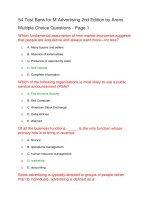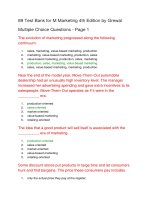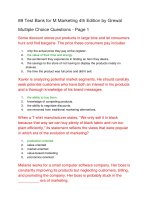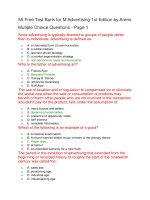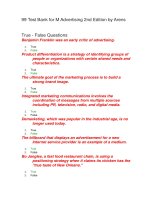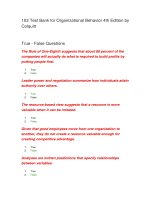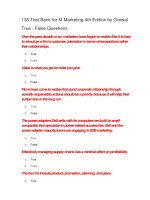95 test bank for m business 4th edition by ferrell
Bạn đang xem bản rút gọn của tài liệu. Xem và tải ngay bản đầy đủ của tài liệu tại đây (115.59 KB, 25 trang )
95 Test Bank for M Business 4th Edition by Ferrell
25 Test Bank True – False Questions
20 Test Bank Free Text Questions
50 Free Multiple Choice Questions
All the groups that have an interest in an organization's success and
outcomes are known as the organization's ____.
1.
agencies
2.
stakeholders
3.
owners
4.
investors
5.
shareholders
All of the following emerged in the U.S. as a result of the manufacturing
and marketing economies, EXCEPT:
1.
buying on credit.
2.
widespread use of assembly lines.
3.
advertising.
4.
farming.
5.
marketing research.
When different businesses can promote similar products based on
different features, and consumers are willing to pay more for products
containing the features they desire, the competitive environment is most
likely to be:
1.
monopolistic competition.
2.
pure competition.
3.
an oligopoly.
4.
a monopoly.
5.
socialist.
When a business fails or does not make a profit, _____ have the most to
lose in terms of finances.
1.
consumers
2.
media agencies
3.
government bodies
4.
owners
5.
market experts
_____ is the study of how resources are distributed for the production of
goods and services within a social system.
1.
Public relations
2.
Sociology
3.
Demographics
4.
Psychographics
5.
Economics
Which of the following statements is true about businesses and profits?
1.
Profit making is a business activity that seldom requires risk taking.
2.
Businesses do not have the right to use their profits the way they choose.
3.
Profit-making businesses often weaken the economy of a country.
4.
Earning profits contributes to society by providing employment.
5.
Businesses have found that the best way to make profits is by ignoring the
interests of stakeholders.
Economic expansion occurs when:
1.
fewer goods and services are produced than consumer demand.
2.
an economy is growing and people are spending more money.
3.
a nation's standard of living drops dramatically.
4.
employment levels decline over time.
5.
prices begin to rise and incomes begin to fall.
As U.S. consumers get busier and earn more money, they hire others to
do tasks such as house cleaning, laundry, and landscaping, resulting in
the development of a(n) _____ economy focused on making life easier for
busy consumers.
1.
manufacturing
2.
service-based
3.
agricultural
4.
technology-based
5.
marketing
In which of the following markets is there most likely to be a monopoly?
1.
Agricultural commodities
2.
Lifestyle gadgets
3.
Airlines
4.
Electricity supply
5.
Sports utility vehicles
____ is often called the father of capitalism.
1.
Karl Marx
2.
George Washington
3.
Benjamin Franklin
4.
Alan Greenspan
5.
Adam Smith
_____ measures changes in the prices of goods and services purchased
for consumption by typical urban households.
1.
GDP
2.
Per capita income
3.
Worker productivity
4.
Trade balance
5.
Consumer price index
_____ refers to all activities concerned with obtaining and managing
money and using it effectively.
1.
Public relations
2.
Marketing
3.
Production
4.
Advertising
5.
Finance
The _____ is the price at which the number of products that businesses
are willing to supply equals the number of products consumers are willing
to purchase at a point in time.
1.
bundled price
2.
equilibrium price
3.
discount price
4.
competitive price
5.
maximum retail price
_____ relates to the number of goods and services that consumers are
willing to buy at different prices at a specific time.
1.
Demand
2.
Supply
3.
Elasticity
4.
Balance of payments
5.
Deficit
Which of the following is a force within an organization's control that has
an impact on the business's daily operations?
1.
Employees
2.
Regulatory environment
3.
Competition
4.
Political environment
5.
Technology
In a capitalist economic system:
1.
the government owns and operates all businesses.
2.
there is little scope for competition.
3.
consumers have a limited choice of goods and services.
4.
the majority of people possesses government jobs.
5.
prices of goods and services are determined by demand and supply.
The market for corn in Brazil has a large number of sellers, and there is no
difference in the products sold by each seller. As there are also a large
number of buyers for the corn, the actions of a single seller or buyer
cannot affect the price. The market for corn can be described as ____.
1.
a monopoly
2.
monopolistic competition
3.
pure competition
4.
an oligopoly
5.
modified competition
Using the supply and demand curves shown in the graph that follows,
what is the equilibrium price for soft drinks?
1.
35 cents
2.
45 cents
3.
50 cents
4.
55 cents
5.
75 cents
_____ indicates the income level of "average" Americans. It is useful in
determining how much "average" consumers spend and how much
money Americans are earning.
1.
Per capita income
2.
GDP
3.
Budget deficit
4.
Consumer price index
5.
Worker productivity
A budget deficit occurs when a nation:
1.
reduces its expenditures.
2.
receives excess taxes.
3.
has no national debts.
4.
spends more than it takes in from taxes.
5.
balances taxes and expenditures.
Following a bad harvest, the prices of agricultural commodities in Urbania
have increased dramatically, as have the prices of products manufactured
from agricultural commodities. Government intervention has failed to
arrest the rising prices. Based on this information, Urbania is undergoing
____.
1.
deflation
2.
stagflation
3.
contraction
4.
depression
5.
inflation
The American economic system is best described as _____ because the
government regulates business to preserve competition and protect
consumers and employees.
1.
socialist
2.
laissez-faire capitalist
3.
modified capitalist
4.
communist
5.
Marxist
Which of the following is a factor of production for a firm?
1.
Advertising media
2.
Legal consultants
3.
Customers
4.
Natural resources
5.
Company reputation
Egalitarianism refers to the:
1.
exemption of taxes for successful businesses.
2.
restrictions on taking up non-government jobs.
3.
equal distribution of income and social services.
4.
concept of the rich getting richer and the poor getting poorer.
5.
restriction of competition in small businesses by government regulations.
Increased unemployment can reduce consumer demand for goods and
services, leading to:
1.
economic expansion.
2.
inflation.
3.
deflation.
4.
budget surplus.
5.
recovery.
What is the primary lesson to be learned from the economic scandals of
the early 21st century?
1.
Ethical conduct and corporate social responsibility are linked to increased profits.
2.
Businesses do not need to consider social values in the contemporary scenario.
3.
Investors and retired employees remain unaffected in case of scandals.
4.
Businesses' reputations depend solely on their profits.
5.
Business misconduct is likely to be widely excused if it enhances firms' profits.
In the history of the American economy, the period following the Industrial
Revolution was known for an increasing emphasis on:
1.
services.
2.
artisanship.
3.
manufacturing.
4.
agriculture.
5.
information.
_____ exists when there are many small businesses selling one
standardized product.
1.
Monopolistic competition
2.
Oligopoly
3.
Pure competition
4.
Monopoly
5.
Monopsony
Which of the following statements is true about GDP as a measure of a
country's economic health?
1.
It does not include the services produced in a country.
2.
It measures only those goods and services made within a country.
3.
It includes profits from companies' overseas operations.
4.
5.
It does not include profits earned by foreign companies within the country being
measured.
It essentially takes into account the concept of GDP in relation to population.
Which of the following is NOT a product?
1.
A Dell personal computer
2.
A veterinarian's treatment of a pet's injuries
3.
A lawyer's advice in a divorce case
4.
A checkup by a doctor
5.
A business profit
The entrepreneur has been primarily associated with willingness to:
1.
change employers frequently.
2.
work under authority.
3.
be conservative.
4.
possess a government job.
5.
take risks.
Economic contraction is said to have occurred when:
1.
GDP increases.
2.
spending declines.
3.
jobs increase.
4.
inflation decreases.
5.
unemployment falls.
When there is only one business providing a product in a given market,
there exists:
1.
an oligopoly.
2.
modified competition.
3.
pure competition.
4.
monopolistic competition.
5.
a monopoly.
Which of the following statements is true about communism?
1.
2.
It is characterized by the government owning and operating most businesses.
It relies on supply and demand to make decisions about pricing and production of
goods.
3.
It encourages private ownership of the means of production.
4.
It encourages free market and competition.
5.
It provides scope for the production of a large variety of goods and services.
_____ gather information and conduct research to determine what
customers want. They also plan and develop products and make
decisions about how much to charge for their products and when and
where to make them available.
1.
Accountants
2.
Engineers
3.
Marketers
4.
Supervisors
5.
Stock brokers
Businesses differ from nonprofit organizations in that a business's focus
is on:
1.
profit.
2.
goods.
3.
price.
4.
charity.
5.
fund raising.
Generally, when a retailer announces a discount sale on all its products:
1.
consumers will not demand more than normal.
2.
the store will not supply more products than it normally does.
3.
consumers will demand more products.
4.
the manufacturer will halt production.
5.
consumers will demand fewer products than normal.
Which of the following is a change that occurred in the U.S. during the
Industrial Revolution?
1.
Farm production decreased as industrial production increased.
2.
As work became more localized, productivity decreased.
3.
Trade within the country decreased as regions became self-sufficient.
4.
Farmers began to move to cities to find jobs in factories.
5.
Fewer goods were available, and prices of goods increased.
Which of the following is true of the responsibilities of the people involved
in a business?
1.
Finance is concerned with acquiring, developing, and using human effectively and
efficiently.
2.
Marketing refers to all activities concerned with obtaining money for the firm and
using it effectively.
3.
Nonprofit organizations include all the functions that businesses do, except for the
marketing function.
4.
Management is not involved in the day-to-day functions of production and
manufacturing.
5.
It is the primary responsibility of the owners to provide financial resources for the
operation of the business.
The functions of organizing, staffing, planning, and controlling are most
closely associated with:
1.
managers.
2.
assembly line workers.
3.
investment advisors.
4.
stockbrokers.
5.
direct sales executives.
Advertising, personal selling, coupons, and sweepstakes are forms of the
_____ aspect of marketing activities.
1.
finance
2.
promotion
3.
production
4.
fund raising
5.
social responsibility
All the following are factors of production used to make goods and
services, EXCEPT:
1.
natural resources.
2.
human resources.
3.
customers.
4.
capital.
5.
financial resources.
In a socialist economic system:
1.
individuals own and operate all businesses.
2.
very few people work for government organizations.
3.
competition is restricted in major industries.
4.
there is no concept of small businesses owned by individuals.
5.
demand and supply have no role to play in the pricing of products and services.
A condition characterized by continuing rise in prices over a period of
time refers to:
1.
inflation.
2.
economic expansion.
3.
a recession.
4.
economic contraction.
5.
deflation.
A firm's _____ resources are also known as labor.
1.
economic
2.
human
3.
intangible
4.
financial
5.
natural
____ is the primary goal of business.
1.
Charity
2.
Profit
3.
Bureaucracy
4.
Quality
5.
Strategy
Financial resources are also known as ____.
1.
capital
2.
labor
3.
barter
4.
natural resources
5.
exchange
Which of the following is a similarity between businesses and nonprofit
organizations?
1.
Both do not have to abide by government regulations.
2.
Both are unaffected by political or social change.
3.
Both of them engage in management and finance activities.
4.
Both of them do not need to adapt to technological changes.
5.
Both aim to maximize financial returns for their owners.
Before the Industrial Revolution, the economy of North America under the
colonists was characterized by:
1.
hunting and gathering instead of agriculture.
2.
the export of manufactured goods to England.
3.
a scarcity of natural resources.
4.
dependence on England for everyday goods.
5.
the domestic system of manufacture of goods.
Which of the following is an example of an intangible product?
1.
A movie DVD
2.
A sandwich
3.
A sports car
4.
A music concert
5.
Jewelry
25 Free Test Bank for M Business 4th Edition by
Ferrell True - False Questions
Owners have little responsibility to provide funds for the operation of the
business.
1.
True
2.
False
Gross domestic product is the sum of all goods and services produced in
a country during a year.
1.
True
2.
False
Nonprofit organizations such as Habitat for Humanity do not engage in
management, marketing, or finance activities.
1.
True
2.
False
The equilibrium price is represented by the point where a product's supply
and demand curves intersect.
1.
True
2.
False
Owners always manage their businesses.
1.
True
2.
False
Free-market capitalism and laissez-faire capitalism are essentially the
same thing.
1.
True
2.
False
The focus of all marketing activities is customer satisfaction.
1.
True
2.
False
A product's equilibrium price is constantly changing in response to
changes in economic conditions, availability of resources, and degree of
competition.
1.
True
2.
False
Demand is the quantity of goods and services that consumers are willing
to buy at different prices at a specific time.
1.
True
2.
False
Most socialist nations are democratic.
1.
True
2.
False
Monopolistic competition exists when there is only one producer of a
product in a given market.
1.
True
2.
False
Managers coordinate resources to achieve the firm's goals.
1.
True
2.
False
The standard of living rises when people have less money to spend.
1.
True
2.
False
Products have only tangible attributes.
1.
True
2.
False
A severe recession may turn into a depression.
1.
True
2.
False
Finance refers to all activities concerned with obtaining money and using
it effectively.
1.
True
2.
False
Businesses have the right to keep and use their profits as they choose,
without limitations.
1.
True
2.
False
After World War II, the United States became an agricultural economy.
1.
True
2.
False
In a free-market system, the government regulates business.
1.
True
2.
False
An oligopoly exists when there are many small businesses selling one
standardized product.
1.
True
2.
False
When a nation takes more from taxes than it spends, it has a budget
deficit.
1.
True
2.
False
Profit is what it costs to make and sell a product.
1.
True
2.
False
Capitalism is an economic system in which the government owns and
operates basic industries while individuals own most other businesses.
1.
True
2.
False
A central issue of economics is how to fulfill an unlimited demand for
goods and services in a world with limited resources.
1.
True
2.
False
The primary goal of business activities is profit.
1.
True
2.
False
20 Free Test Bank for M Business 4th Edition by
Ferrell Free Text Questions
What impact did the Industrial Revolution in the nineteenth century have
on the American economy?
Answer Given
The nineteenth century and the Industrial Revolution brought the development of
new technology and factories. The factory brought together all the resources
needed to make a product—materials, machines, and workers. Work in factories
became specialized as workers focused on one or two tasks. As work became
more efficient, productivity increased, making more goods available at lower
prices. Railroads brought major changes, allowing farmers to send their surplus
crops and goods all over the nation for barter or for sale. Rising productivity also
permitted many farmers to move to the cities to find higher-paying factory jobs.
Why are entrepreneurs important to the economy?
Answer Given
Entrepreneurs are important to the economy because they are willing to take the
risks necessary to bring ideas for new goods, services, and business practices
into the marketplace. They bring together all the factors of production to produce
new products.
Define supply, demand, and equilibrium price, and explain their
relationship with each other.
Answer Given
Supply is the quantity of goods or services that businesses are willing to sell at
different prices at a specific time. Demand is the quantity of goods or services that
consumers are willing to buy at different prices at a specific time. Both can be
shown graphically with supply and demand curves. Where the supply and demand
curves intersect is the equilibrium price, the price at which the quantity of products
businesses are willing to supply equals the quantity of products consumers are
willing to buy at a specific point in time. If economic conditions, resource
availability, degree of competition, or some other factor changes either supply or
demand, a new equilibrium price will be established.
What are the people and activities of business? Define each group.
Answer Given
The people of business are owners, employees, and customers. Owners have to
put up resources—money or credit—to start a business. Employees-including
managers—are responsible for the work that goes on within a business. Owners
can manage the business themselves or hire employees to accomplish this task.
A business's most important role is to satisfy the customers who buy its goods or
services. The major activities of business are management, marketing and
finance.
What are the basic individual and business rights that must exist for free
enterprise to work?
Answer Given
A number of basic individual and business rights must exist for free enterprise to
work. These rights are the goals of many countries that have recently embraced
free enterprise: Individuals must have the right to own property and to pass this
property on to their heirs. This right motivates people to work hard and save to buy
property; Individuals and businesses must have the right to earn profits and to use
the profits as they wish, within the constraints of their society's laws, principles,
and values; Individuals and businesses must have the right to make decisions that
determine the way the business operates; Although there is government
regulation, the philosophy in countries like the United States and Australia is to
permit maximum freedom within a set of rules of fairness; Individuals must have
the right to choose what career to pursue, where to live, what goods and services
to purchase, and more. Businesses must have the right to choose where to locate,
what goods and services to produce, what resources to use in the production
process, and so on.
How is Gross Domestic Product (GDP) used as a measure of a nation's
economic health?
Answer Given
One commonly used economic measure is gross domestic product (GDP)—the
sum of all goods and services produced in a country during a year. GDP
measures only those goods and services made within a country and therefore
does not include profits from companies' overseas operations; it does include
profits earned by foreign companies within the country being measured. However,
it does not take into account the concept of GDP in relation to population (GDP
per capita).
Differentiate between communist and capitalist economic systems.
Answer Given
Karl Marx (1818-1883) first described communism as a society in which the
people, without regard to class, own all the nation's resources. In his ideal
political-economic system, everyone contributes according to ability and receives
benefits according to need. In a communist economy, the people (through the
government) own and operate all businesses and factors of production. Central
government planning determines what goods and services satisfy citizens' needs,
how the goods and services are produced, and how they are distributed.
Capitalism, or free enterprise, is an economic system in which individuals own and
operate the majority of businesses that provide goods and services. Competition,
supply, and demand determine which goods and services are produced, how they
are produced, and how they are distributed.
Define economic expansion. What factors are responsible for it?
Answer Given
Economies are not stagnant; they expand and contract. Economic expansion
occurs when an economy is growing and people are spending more money. Their
purchases stimulate the production of goods and services, which in turn stimulates
employment. The standard of living rises because more people are employed and
have money to spend. Rapid expansions of the economy, however, may result in
inflation, a continuing rise in prices.
Describe the role of ethics and social responsibility in business today
Answer Given
In the past few years, a number of scandals in large corporations have
undermined consumers' faith in businesses. These scandals have increased
consumer focus on the ethics of large companies. Society is increasingly
demanding that businesspeople behave ethically and socially responsibly toward
not only their customers but also their employees, investors, government
regulators, communities, and the natural environment. While one view is that
ethics and social responsibility are a good supplement to business activities, there
is an alternative viewpoint. Research has shown that ethical behavior can not only
enhance a company's reputation but can also drive profits. There is growing
recognition that the long-term value of conducting business in an ethical and
socially responsible manner that considers the interests of all stakeholders creates
superior financial performance.
What are nonprofit organizations? Differentiate between nonprofit
organizations and businesses.
Answer Given
Nonprofit organizations are organizations that may provide goods or services but
do not have the fundamental purpose of earning profits. Nonprofit organizations,
such as the Red Cross, Special Olympics, and other charities and social causes,
do not have the fundamental purpose of earning profits, although they may
provide goods or services and engage in fund raising. Businesses, on the other
hand, try to earn a profit by providing products that satisfy people's needs.
Describe the role of government in the United States' economy.
Answer Given
The economic system of the United States is best described as modified
capitalism because the government regulates business to preserve competition
and protect consumers and employees. Federal, state, and local governments
intervene in the economy with laws and regulations designed to promote
competition and to protect consumers, employees, and the environment.
Additionally, government agencies such as the U.S. Department of Commerce
measure the health of the economy (GDP, productivity, etc.) and, when
necessary, take steps to minimize the disruptive effects of economic fluctuations
and reduce unemployment.
What are the factors of production? Briefly describe each one.
Answer Given
Land, forests, minerals, water, and other things that are not made by people are
natural resources. Human resources, or labor, refer to the physical and mental
abilities that people use to produce goods and services. Financial resources, or
capital, are the funds used to acquire the natural and human resources needed to
provide products. Because natural, human, and financial resources are used to
produce goods and services, they are sometimes called factors of production.
Define competition, and describe the different forms it can take.
Answer Given
Competition, the rivalry among businesses for consumers' dollars, is a vital
element in free enterprise. Pure competition exists when there are many small
businesses selling one standardized product, such as agricultural commodities
like wheat, corn, and cotton. Monopolistic competition exists when there are fewer
businesses than in a pure-competition environment and the differences among the
goods they sell are small. An oligopoly exists when there are very few businesses
selling a product. In an oligopoly, individual businesses have control over their
products' price because each business supplies a large portion of the products
sold in the marketplace. Where there is just one business supplying a product for
a given market, a monopoly exists. Monopolies may be permitted because the
cost of developing or supplying the product may be so great that new firms could
not compete.
Briefly describe the goals of a business, especially the primary goal.
Answer Given
The primary goal of business is profit, the difference between what it costs to
make and sell a product and what the customer pays for it. Other business goals
may include acting ethically and being socially responsible.
Describe the pre-industrial economic phases of the United States.
Answer Given
Before the colonization of North America, Native Americans lived as
hunter/gatherers and farmers, with some trade among tribes. The colonists who
came later operated primarily as an agricultural economy. People were selfsufficient and produced everything they needed at home, including food, clothing,
and furniture. Abundant natural resources and a moderate climate nourished
industries such as farming, fishing, shipping, and fur trading. A few manufactured
goods and money for the colonies' burgeoning industries came from England and
other countries.
Describe the relationship between management, marketing, and finance.
Answer Given
Management, marketing, and finance are the primary business activities.
Management involves coordinating the efforts of employees to achieve
organizational objectives. Marketing involves activities designed to provide goods
and services that satisfy customers. Finance involves activities concerned with
obtaining money—from owners and investors and other sources—and using it
effectively
What is a service economy? What factors led to the United States
becoming a service economy?
Answer Given
After World War II, continued improvements in productivity and standard of living
left many Americans with more money and time. They began to pay others to do
tasks they used to do at home, like cooking, laundry, landscaping, and child care.
These trends have gradually changed the United States to a service economy—
one devoted to the production of services that make life easier for busy
consumers. Businesses increased their demand for services, especially in the
areas of finance and information technology.
What are the three main questions that all economic systems must
answer? Who answers them under a communist system? A socialist
system? A capitalist system?
Answer Given
The three economic questions are (1) What goods and services and how much of
each will satisfy the needs of the consumer? (2) How will goods and services be
produced and who will produce them and with what resources? (3) How are the
goods and services to be distributed to the consumer? Under a true communist
system, these questions are answered by a central government planning
committee. Under a true socialist system, a central government planning
committee answers the questions for basic goods and industries, while the forces
of supply and demand answer them for most other products. Within a capitalist
system, competition, supply, and demand determine the answers.
What is an economic contraction, and to what can it lead?
Answer Given
Economic contraction occurs when spending declines. Businesses cut back on
production and lay off workers, and the economy as a whole slows down.
Contractions of the economy lead to recession—a decline in production,
employment, and income. Recessions are often characterized by rising levels of
unemployment, which is measured as the percentage of the population that wants
to work but is unable to find jobs.
Define budget deficit. What are the factors responsible for a budget
deficit?
Answer Given
One important indicator of a nation's economic health is the relationship between
its spending and income (from taxes). When a nation spends more than it takes in
from taxes, it has a budget deficit. Although the U.S. eliminated its long-standing
budget deficit during the 1990s, it re-emerged and grew to record levels during the
early 2000s.
